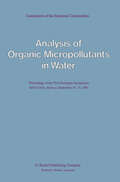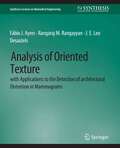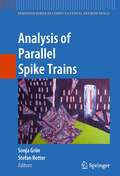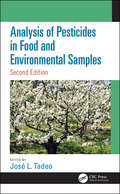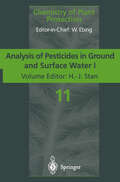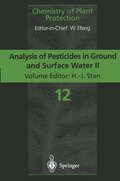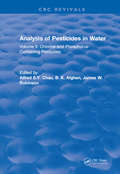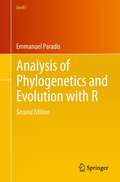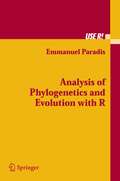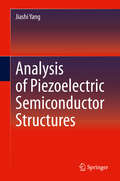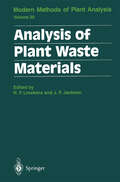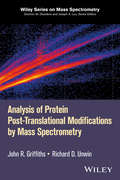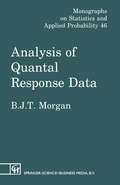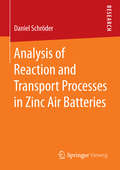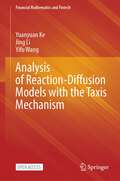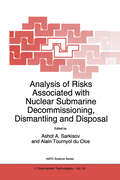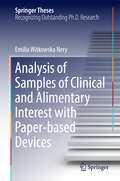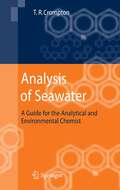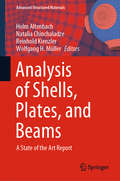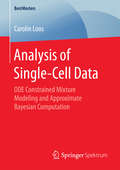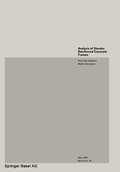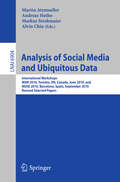- Table View
- List View
Analysis of Organic Micropollutants in Water: Proceedings of the Third European Symposium held in Oslo, Norway, September 19–21, 1983
by G. Angeletti A. BjørsethIn this book, the proceedings of the Third European Symposium on "Analysis of Organic Micropollutants in Water", held in Oslo (Norway), from 19 to 21 September 1983, are presented. The symposium was organized within the framework of the Concerted Ac tion COST 64b bis *, which has the same name and is included in the Third R&D Programme on Environment of the Commission of the European Communi ties - Indirect and Concerted Actions - 1981 to 1985. The aim of the symposium was to review the progress and results achiev ed during the past two years, since the Second symposium, held in Killarney (Ireland) in November 1981. The programme of the symposium consisted of review papers covering dif ferent areas related to the analysis of the organic pollutants in water, in cluding sampling and sample treatment, gas and liquid chromatography, mass spectrometry and specific analytical problems for some types of compounds. We think that the volume gives a rather complete overview of these activities in Europe. Moreover, the paper presented by D. Hunt reviews the development of the new technique mass spectrometry - mass spectrometry in the United States of America. Some special sessions concerned the presentation of original contri butions in form of poster, the extended versions of which are published in this volume.
Analysis of Oriented Texture with application to the Detection of Architectural Distortion in Mammograms (Synthesis Lectures on Biomedical Engineering)
by Fabio Ayres Rangaraj RangayyanThe presence of oriented features in images often conveys important information about the scene or the objects contained; the analysis of oriented patterns is an important task in the general framework of image understanding. As in many other applications of computer vision, the general framework for the understanding of oriented features in images can be divided into low- and high-level analysis. In the context of the study of oriented features, low-level analysis includes the detection of oriented features in images; a measure of the local magnitude and orientation of oriented features over the entire region of analysis in the image is called the orientation field. High-level analysis relates to the discovery of patterns in the orientation field, usually by associating the structure perceived in the orientation field with a geometrical model. This book presents an analysis of several important methods for the detection of oriented features in images, and a discussion of the phase portrait method for high-level analysis of orientation fields. In order to illustrate the concepts developed throughout the book, an application is presented of the phase portrait method to computer-aided detection of architectural distortion in mammograms. Table of Contents: Detection of Oriented Features in Images / Analysis of Oriented Patterns Using Phase Portraits / Optimization Techniques / Detection of Sites of Architectural Distortion in Mammograms
Analysis of Parallel Spike Trains (Springer Series in Computational Neuroscience #7)
by Sonja Grün Stefan RotterSolid and transparent data analysis is the most important basis for reliable interpretation of experiments. The technique of parallel spike train recordings using multi-electrode arrangements has been available for many decades now, but only recently gained wide popularity among electro physiologists. Many traditional analysis methods are based on firing rates obtained by trial-averaging, and some of the assumptions for such procedures to work can be ignored without serious consequences. The situation is different for correlation analysis, the result of which may be considerably distorted if certain critical assumptions are violated. The focus of this book is on concepts and methods of correlation analysis (synchrony, patterns, rate covariance), combined with a solid introduction into approaches for single spike trains, which represent the basis of correlations analysis. The book also emphasizes pitfalls and potential wrong interpretations of data due to violations of critical assumptions.
Analysis of Pesticides in Food and Environmental Samples, Second Edition
by Jose L. TadeoThis book provides a critical overview of analytical methods used for the determination of pesticide residues and other contaminants in food and environmental samples by modern instrumental analysis. It contains up-to-date material including recent trends in sample preparation, general methods used for pesticide analysis and quality assurance aspects, and chromatographic and immunoassay methods. The rest of the book describes particular analytical methods used for the determination of pesticides in food and soil, water and air. In addition, the levels of these chemicals found in food, their regulatory aspects and the monitoring of pesticides in the environment are described.
Analysis of Pesticides in Food and Environmental Samples, Second Edition
by Jose L. TadeoThis book provides a critical overview of analytical methods used for the determination of pesticide residues and other contaminants in food and environmental samples by modern instrumental analysis. It contains up-to-date material including recent trends in sample preparation, general methods used for pesticide analysis and quality assurance aspects, and chromatographic and immunoassay methods. The rest of the book describes particular analytical methods used for the determination of pesticides in food and soil, water and air. In addition, the levels of these chemicals found in food, their regulatory aspects and the monitoring of pesticides in the environment are described.
Analysis of Pesticides in Ground and Surface Water I: Progress in Basic Multi-Residue Methods (Chemistry of Plant Protection #11)
by M. Akerblom H. Egli P. Günther T. Heberer P. T. Holland R. L. Jones W. Pestemer K. Rubach H. J. StanPublic concern is being increasingly directed to pesticides and their residues in ground and surface waters. Water - one of the necessities of life - has to be kept clean for man and the environment. Part I and II of this book describe in an authoritative way all aspects of modern analysis of pesticides in water by the consequent use of hyphenated techniques like GC-AED or HPLC-MS.
Analysis of Pesticides in Ground and Surface Water II: Latest Developments and State-of-the-Art of Multiple Residue Methods (Chemistry of Plant Protection #12)
by A. Brandt U.A.T. Brinkmann S. Butz K. Burger J. Keever K. Levsen M. Linkerhäger A.J.H. Louter T.H.M. Noij B. F. Scott H. J. Stan D. Volmer R. D. Voyksner J. J. Vreruls P. L. WyliePublic concern is being increasingly directed to pesticides and their residues in ground and surface waters. Water - one of the necessities of life - has to be kept clean for man and the environment. Part I and II of this book describe in an authoritative way all aspects of modern analysis of pesticides in water by the consequent use of hyphenated techniques like GC-AED or HPLC-MS.
Analysis of Pesticides in Water: Volume II: Chlorine-and Phosphorus- Containing Pesticides
by Alfred S.Y. ChauThis book, collected by Mr. Chau and Dr. Afghan, is devoted to the broad and important topic of pesticides. It examines important facets such as the significance of the problem, the chemistry of pesticides, and principles and techniques. It will provide excellent reference material for producers, users and testing agencies.
Analysis of Pesticides in Water: Volume II: Chlorine-and Phosphorus- Containing Pesticides
by Alfred S.Y. ChauThis book, collected by Mr. Chau and Dr. Afghan, is devoted to the broad and important topic of pesticides. It examines important facets such as the significance of the problem, the chemistry of pesticides, and principles and techniques. It will provide excellent reference material for producers, users and testing agencies.
Analysis of Phylogenetics and Evolution with R (Use R!)
by Emmanuel ParadisThe increasing availability of molecular and genetic databases coupled with the growing power of computers gives biologists opportunities to address new issues, such as the patterns of molecular evolution, and re-assess old ones, such as the role of adaptation in species diversification.In the second edition, the book continues to integrate a wide variety of data analysis methods into a single and flexible interface: the R language. This open source language is available for a wide range of computer systems and has been adopted as a computational environment by many authors of statistical software. Adopting R as a main tool for phylogenetic analyses will ease the workflow in biologists' data analyses, ensure greater scientific repeatability, and enhance the exchange of ideas and methodological developments. The second edition is completed updated, covering the full gamut of R packages for this area that have been introduced to the market since its previous publication five years ago. There is also a new chapter on the simulation of evolutionary data. Graduate students and researchers in evolutionary biology can use this book as a reference for data analyses, whereas researchers in bioinformatics interested in evolutionary analyses will learn how to implement these methods in R. The book starts with a presentation of different R packages and gives a short introduction to R for phylogeneticists unfamiliar with this language. The basic phylogenetic topics are covered: manipulation of phylogenetic data, phylogeny estimation, tree drawing, phylogenetic comparative methods, and estimation of ancestral characters. The chapter on tree drawing uses R's powerful graphical environment. A section deals with the analysis of diversification with phylogenies, one of the author's favorite research topics. The last chapter is devoted to the development of phylogenetic methods with R and interfaces with other languages (C and C++). Some exercises conclude these chapters.
Analysis of Phylogenetics and Evolution with R (Use R!)
by Emmanuel ParadisThis book integrates a wide variety of data analysis methods into a single and flexible interface: the R language. The book starts with a presentation of different R packages and gives a short introduction to R for phylogeneticists unfamiliar with this language. The basic phylogenetic topics are covered. The chapter on tree drawing uses R's powerful graphical environment. A section deals with the analysis of diversification with phylogenies, one of the author's favorite research topics. The last chapter is devoted to the development of phylogenetic methods with R and interfaces with other languages (C and C++). Some exercises conclude these chapters.
Analysis of Piezoelectric Semiconductor Structures
by Jiashi YangThis book presents the mechanics of piezoelectric semiconductor structures where the main electromechanical coupling of interest is the interaction between mechanical fields and semiconduction. This volume stands as the first full book treatment of this multi-physical subject from the mechanics angle. The analysis of piezoelectric semiconductor structures and devices is an emerging and rapidly growing interdisciplinary area involving materials, electronics, and solid mechanics. It has direct applications in the new area of piezotronics and piezo-phototronics. The book is theoretical, beginning with a phenomenological framework and progressing to include solutions to problems fundamental to the theory and application. Dr. Yang illustrates how in piezoelectric semiconductors, mechanical fields interact with semiconduction through the piezoelectrically produced electric fields by mechanical loads. This provides the foundation of piezotronic and piezo-phototronic devices in which semiconduction is induced, affected, manipulated, or controlled by mechanical fields. Also discussing composite structures of piezoelectric dielectrics and nonpiezoelectric semiconductors as well as thermal effects, the book is an ideal basic reference on the topic for researchers.
Analysis of Plant Waste Materials (Molecular Methods of Plant Analysis #20)
by Hans F. Linskens John F. JacksonModern Methods of Plant Analysis When the handbook Modern Methods of Plant Analysis, was first introduced in 1954, the considerations were: 1. the dependence of scientific progress in biology on the improvement of existing and the introduction of new methods; 2. the difficulty in finding many new analytical methods in specialized journals which are normally not accessible to experimental plant biologists; 3. the fact that in the methods sections of papers the description of methods is frequently so compact, or even sometimes so incomplete, that it is difficult to reproduce experiments. These considerations still stand today. The series was highly successful, seven volumes appearing between 1956 and 1964. Since there is still today a demand for the old series, the publisher has decided to resume publication of Modern Methods of Plant Analysis. It is hoped that the New Series will be just as acceptable to those working in plant sciences and related fields as the early volumes undoubtedly were. It is difficult to single out the major reasons for the success of any publication, but we believe that the methods published in the first series were up-to-date at the time and presented in a way that made description, as applied to plant material, complete in itself with little need to consult other publications. Contribution authors have attempted to follow these guidelines in this New Series of volumes. Editorial The earlier series of Modern Methods of Plant Analysis was initiated by Michel V.
Analysis of Protein Post-Translational Modifications by Mass Spectrometry (Wiley Series on Mass Spectrometry)
by John R. Griffiths Richard D. UnwinCovers all major modifications, including phosphorylation, glycosylation, acetylation, ubiquitination, sulfonation and and glycation Discussion of the chemistry behind each modification, along with key methods and references Contributions from some of the leading researchers in the field A valuable reference source for all laboratories undertaking proteomics, mass spectrometry and post-translational modification research
Analysis of Protein Post-Translational Modifications by Mass Spectrometry (Wiley Series on Mass Spectrometry)
by John R. Griffiths Richard D. UnwinCovers all major modifications, including phosphorylation, glycosylation, acetylation, ubiquitination, sulfonation and and glycation Discussion of the chemistry behind each modification, along with key methods and references Contributions from some of the leading researchers in the field A valuable reference source for all laboratories undertaking proteomics, mass spectrometry and post-translational modification research
Analysis of Quantal Response Data (Monographs on Statistics and Applied Probability #46)
by Byron J. MorganAnalysis of Reaction and Transport Processes in Zinc Air Batteries
by Daniel SchröderThis book contains a novel combination of experimental and model-based investigations, elucidating the complex processes inside zinc air batteries. The work presented helps to answer which battery composition and which air-composition should be adjusted to maintain stable and efficient charge/discharge cycling. In detail, electrochemical investigations and X-ray transmission tomography are applied on button cell zinc air batteries and in-house set-ups. Moreover, model-based investigations of the battery anode and the impact of relative humidity, active operation, carbon dioxide and oxygen on zinc air battery operation are presented. The techniques used in this work complement each other well and yield an unprecedented understanding of zinc air batteries. The methods applied are adaptable and can potentially be applied to gain further understanding of other metal air batteries.
Analysis of Reaction-Diffusion Models with the Taxis Mechanism (Financial Mathematics and Fintech)
by Yuanyuan Ke Jing Li Yifu WangThis open access book deals with a rich variety of taxis-type cross-diffusive equations. Particularly, it intends to show the key role played by quasi-energy inequality in the derivation of some necessary a priori estimates. This book addresses applied mathematics and all researchers interested in mathematical development of reaction-diffusion theory and its application and can be a basis for a graduate course in applied mathematics.
Analysis of Risks Associated with Nuclear Submarine Decommissioning, Dismantling and Disposal (NATO Science Partnership Subseries: 1 #24)
by Ashot A. Sarkisov Alain Tournyol Du ClosA great number of nuclear submarines are due to be decommissioned before 2000. The political decisions surrounding the disposal of nuclear compartments, radioactive wastes and spent fuel differ appreciably between the countries that own the boats. The decision makers involved thus need help in comparing and assessing alternative options for the decommissioning of their nuclear submarine fleets. The present volume offers such assistance, with its discussions of the risks associated with long-term water storage of the boats, radioactive and chemical contamination, spent fuel and waste management, and handling and recycling reactor compartments.
Analysis of Samples of Clinical and Alimentary Interest with Paper-based Devices (Springer Theses)
by Emilia Witkowska NeryThis book presents two main sets of paper-based analytical systems. The first set is a platform for the analysis of glucose, cholesterol and uric acid in biological samples, and the second set is a cutting-edge electronic tongue system for the analysis of beverages (mineral water, beer, wine). This thesis also provides an extensive review of 33 methods of enzyme immobilization on paper which have been evaluated to enhance the storage stability of the proposed system for biomarker detection. From a practical perspective, this thesis covers a diverse set of topics related to paper-based sensing, including colorimetric and electrochemical detection methods, different sets of architecture (spot-tests, lateral and tangential flow assays), methods of fabrication (wax printing, cutting, impregnation with polymers), measurements in stationary and flow conditions as well computer modeling of proposed systems and sophisticated data analysis using chemometric techniques. This book is useful for PhD students working in this or a related field who require detailed information about methodology and background to this research.
Analysis of Seawater: A Guide for the Analytical and Environmental Chemist
by T.R. CromptonThis practice-oriented guidebook collects nearly all methods published since 1975 on the chemical analysis of seawaters. Detailed descriptions of both classical and most advanced physico-chemical and chemical techniques including 45 tables and 48 figures make this volume an invaluable source for analysts, oceanographers, fisheries experts, politicians and decision makers engaged in seawater environmental protection. The methods are presented in a logical manner so that the reader can readily learn to perform them.
Analysis of Shells, Plates, and Beams: A State of the Art Report (Advanced Structured Materials #134)
This book commemorates the 75th birthday of Prof. George Jaiani – Georgia’s leading expert on shell theory. He is also well known outside Georgia for his individual approach to shell theory research and as an organizer of meetings, conferences and schools in the field. The collection of papers presented includes articles by scientists from various countries discussing the state of the art and new trends in the theory of shells, plates, and beams. Chapter 20 is available open access under a Creative Commons Attribution 4.0 International License via link.springer.com.
Analysis of Single-Cell Data: ODE Constrained Mixture Modeling and Approximate Bayesian Computation (BestMasters)
by Carolin LoosCarolin Loos introduces two novel approaches for the analysis of single-cell data. Both approaches can be used to study cellular heterogeneity and therefore advance a holistic understanding of biological processes. The first method, ODE constrained mixture modeling, enables the identification of subpopulation structures and sources of variability in single-cell snapshot data. The second method estimates parameters of single-cell time-lapse data using approximate Bayesian computation and is able to exploit the temporal cross-correlation of the data as well as lineage information.
Analysis of Slender Reinforced Concrete Frames (Institut für Baustatik und Konstruktion #50)
by M. Grenacher Aas-JakobsenAnalysis of Social Media and Ubiquitous Data: International Workshops MSM 2010, Toronto, Canada, June 13, 2010, and MUSE 2010, Barcelona, Spain, September 20, 2010, Revised Selected Papers (Lecture Notes in Computer Science #6904)
by Martin Atzmueller Andreas Hotho Markus Strohmaier Alvin ChinThis book constitutes the joint thoroughly refereed post-proceedings of The Modeling Social Media Workshop, MSM 2010 held in Toronto, Canada in June 2010 and the International Workshop on Mining Ubiquitous and Social Environments, MUSE 2010, held in Barcelona, Spain in September 2010.The eight revised full papers included were carefully reviewed and selected after two rounds of reviewing and revision. The papers address various aspects of the analysis and engineering of socio-computational systems in which social, ubiquitous and computational processes are interdependent and tightly interwoven
